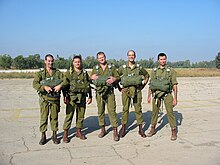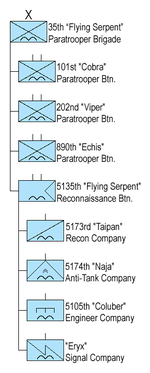Israeli Paratrooper Brigade
The paratrooper brigade (חטיבת הצנחנים, Chativat ha-Zanchanim ; nickname "Flying Snake") is the airborne component of the Israeli armed forces and, as a major military unit, part of the central command . Unlike many other armed forces, the Israeli airborne troops are all trained and equipped for special operations . Their combat value and range of operations is greater and broader than that of conventional airborne troops.
history
The Paratrooper Brigade was formed in 1954 from parts of Unit 101 , a special unit, and Battalion 890 , the first paratrooper command unit in Israel, to form an air-deployable elite unit at the brigade level that can also carry out command and special operations. It was the first unit in Israel to be fully equipped with the Uzi submachine gun . Its first commander was Ariel Sharon , who had previously led unit 101.
Further goals of setting up such a large unit were to improve the general level of training of all infantry units by developing new combat strategies and passing them on in joint maneuvers . In addition, they wanted to form a rapid reaction force that would act as a strategic reserve for the General Staff and be able to carry out covert remote reconnaissance operations in order to always provide it with the latest information for the creation of the current situation picture. Furthermore, this force should form the personal foundation stone for future officers and commanders, in order to promote an understanding of the deployment and military value of special forces.
The paratrooper brigade had its first war mission and large-scale jump operation in 1956 during the Suez Crisis . In 1967 she was involved in the successful conquest of Jerusalem during the Six Day War , together with the Jerusalem Brigade , the Harel Brigade and support from armored forces. The paratroopers captured the Western Wall and the Temple Mount , an action that is seen by the majority of Israeli people as the historic moment of war, given the religious significance of these places .
In the following years the unit produced later chiefs of the general staff, such as Shaul Mofas and Moshe Jaalon .
The paratrooper brigade is currently involved in counter-terrorism operations in the West Bank .
assignment
The training and equipment of the paratrooper brigade is designed for both special and classic military operations. They are light infantry with the task of penetrating deep into enemy territory quickly and unnoticed and also to leave their area of operation in order to obtain information there, carry out raids, disrupt enemy operations, secure landing points for subsequent units and rescue personnel and equipment. In addition, the paratroopers are able to carry out all classic missions of airborne troops and light infantry.
However, their ability to fight armored units is limited because of their light armament. The same applies to air defense and artillery capacities. In addition, the paratroopers only have limited supply capacities and other combat support, which makes them highly dependent on the development of a support infrastructure for longer deployments.
Your current role within the Army Special Operation Command is that of a command unit for direct attack-like combat operations ( direct action ), which is also capable of fighting larger targets on a broad infantry level and, if necessary, capturing them (e.g. airports).
organization
The 35th Parachute Brigade , the current name of the paratrooper brigade comprises three battalions combat troops and Special Forces Battalion (Support Battalion) together and an independent telecommunications - company , which reports directly to the brigade headquarters is under. All units are named after snakes. The numbering of the first battalion, the 101st, is reminiscent of the 101st unit and is intended to continue this line of tradition, the same applies to the second battalion, which bears the number 202, which was formerly named the 202nd Paratrooper Brigade of today's 35th Paratroopers -Bigade should remember. The third battalion is numbered 890, which is intended to remind of the 890th battalion, one of the units that were merged with the paratrooper brigade in 1954 .
The 5173th Taipan Reconnaissance Company ( Sayeret ), which is formally part of the Flying Snake Special Troops Battalion, reports directly to the brigade's headquarters in times of war and is, so to speak, the elite of the elite, as only the most capable soldiers of the brigade have access here.
Subordinate units
Paratrooper units are named after snakes
- 101st Cobra Paratrooper Battalion
- 202nd Viper Paratrooper Battalion
- 890th Echis Paratrooper Battalion ( Echis are sand rattles )
- Flying Snake Special Forces Battalion
- Eryx Telecommunication Company ( Eryx is a sand boa)
Recruitment and training
Service in the paratrooper brigade is basically voluntary and requires a very high level of mental and physical skills. This is why the failure rate in the difficult and sometimes rigid aptitude tests is relatively high, but the influx of applicants is considerable due to the excellent reputation of the 35th Paratrooper Brigade . Since the Israeli armed forces have a highly developed reserve unit system, the obligatory involvement of reservists for temporary active duty takes place annually. There are four other reserve paratrooper brigades. The personnel of these reserve brigades do their reserve service in the 35th Paratrooper Brigade , the only permanently active paratrooper brigade in Israel.
equipment
Uniforms
The uniforms of the paratroopers differ from those of the regular infantrymen. They wear special combat boots that are reddish instead of black. The service uniform ( yerkit ) differs significantly from the standard uniform of the ground forces, and the soldiers wear a red beret. Since the elite character of the 35th Paratrooper Brigade is officially represented by the Ministry of Defense, the soldiers are particularly proud when their membership of a military "elite" is also reflected in different badges and uniforms.
Weapons and equipment
Because of the special operational capabilities of the troops, the 35th Paratrooper Brigade also has different weapon assignments and equipment that is required to carry out these missions.
The unit used Glock 17 and Glock 19 self-loading guns, assault rifles of the type Tavor TAR-21 , submachine guns of the type Micro Uzi and Micro Para Uzi , sniper weapons of the types IMI Galil Galat'z , Mauser 86Sr , M24 and Steyr SSG 69 and pump action of the types Remington 870 and Mossberg .
Memorials

The main memorial for the fallen is on road 40 near Tel Nof between Gedera and Rechovot . It is headed with a Hebrew Bible sentence from 2 Samuel 1:23: "They were faster than eagles and stronger than lions." Another memorial for the fallen paratroopers of special operations can be found between Kibbutz Mefalsim and the Gaza Strip: the "Black Arrow Memorial". The Givat Harabatim at the Moshav Shtula on the Lebanese border commemorates those killed in the Lebanon War of 1982 .
Web links
- Official website of the Paratrooper Brigade (Hebrew and English)
- Website of the traditional association of Israeli paratroopers (Hebrew)
Individual evidence
- ↑ More detailed explanations of this and other Bible passages (at the second memorial) can be found in chapter 1.4. of this online Israel travel guide .




